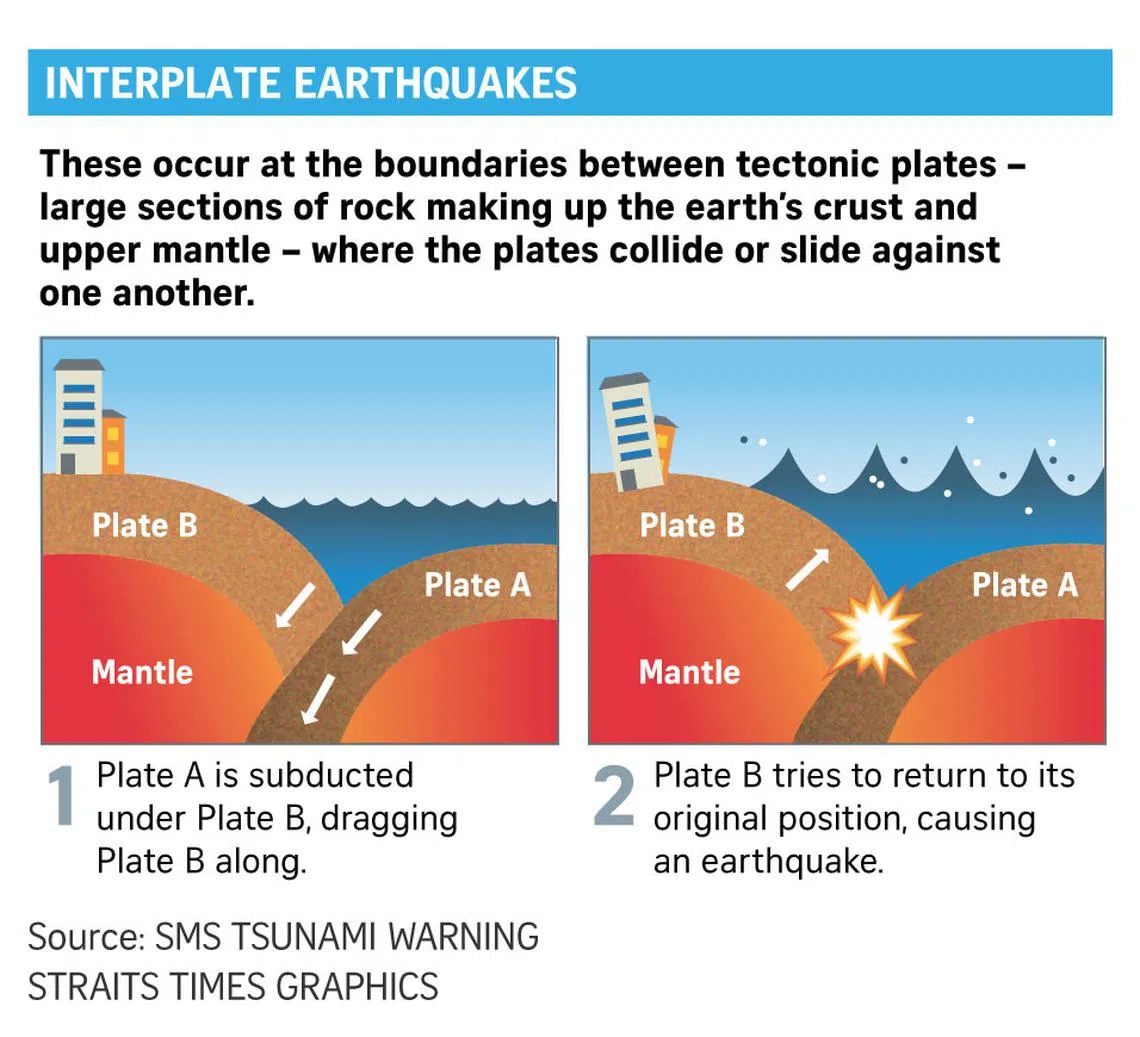ST Explains: What caused the Johor earthquake and is Singapore safe from such tremors?
Sign up now: Get ST's newsletters delivered to your inbox

The earthquake struck Segamat in Johor at 6.13am on Aug 24.
PHOTOS: JIMMY PUAH/FACEBOOK
Follow topic:
SINGAPORE – An earthquake with a magnitude of 4.1 struck Johor on Aug 24, with tremors felt across several states, including Negeri Sembilan and Melaka.
Three more earthquakes with magnitudes ranging between 2.5 and 3.4, were later recorded - totaling to four earthquakes to hit the state in five days.
The epicentre of the first quake was located near Segamat, about 180km from Singapore, said the Malaysian Meteorological Department. No casualties have been reported so far.
The quake was unusual as it did not take place at the boundaries of tectonic plates, where most seismic and volcanic activity usually happens.
Tectonic plates are large sections of rock that make up the earth’s crust and upper mantle. All the world’s oceans and lands sit on these plates, which are constantly moving slowly, a few centimetres a year.
Instead, the Johor quake was likely an “intraplate” one that happened within one tectonic plate, said National University of Singapore senior lecturer of geography Muhammad Nawaz.
“The Johor tremor was likely caused by stress release along a minor fault within the Sunda Plate,” he said.
The Sunda Plate is a tectonic plate located in South-east Asia. It comprises Cambodia, Malaysia, Singapore, Vietnam, Indonesia and parts of the South China Sea and Andaman Sea.
The Straits Times explores the science of earthquakes and whether Singapore is at risk from intraplate quakes.
What causes earthquakes?
Large earthquakes often happen along the edges of tectonic plates, said geologist Aron Meltzner, an assistant professor at NTU’s Asian School of the Environment. “This is why those regions are so dangerous,” he said.
During a process called subduction where one plate moves beneath another, immense pressure builds up and this often leads to powerful earthquakes.
Take, for example, the Pacific Ring of Fire, a horseshoe-shaped series of seismic fault lines around the Pacific Ocean.
This is where the Pacific Plate meets many other surrounding plates. This area is responsible for 90 per cent of the world’s earthquakes and home to 75 per cent of its active volcanoes, reported the National Geographic.
But intraplate earthquakes can happen within a single plate. They can occur when stress builds up slowly over time – slower than at plate boundaries – and is suddenly released along existing cracks or weaknesses in the crust.
The cracks are also known as faults, some of which are more well known than others.

Mild earthquakes, such as the one in Johor on Aug 24, can also happen at faults that are so small they may be hidden and unknown until they produce an earthquake, Prof Meltzner said.
“Because we are far from the plate boundary, stress builds up more slowly here, so earthquakes are much less common in places like Johor or Singapore than in nearby Sumatra,” he said.
Sumatra in Indonesia is located within the Pacific Ring of Fire.
What causes an intraplate earthquake?
It happens when stress builds up within a tectonic plate due to forces from surrounding plate movements or from reactivation of older fault lines, said NUS’ Dr Nawaz.
“Although this region is situated away from active tectonic plate boundaries, intraplate stresses generated by the ongoing movements of the Eurasian, Indo-Australian and Sunda plates can activate local fault systems,” he added.
Johor had also experienced earthquakes in 1922.
Malaysia’s National Disaster Management Agency noted those earthquakes were instances of intraplate seismicity, which means the quakes originated within the tectonic plate rather than at its boundaries.
Such intraplate earthquakes, it noted, are less common and their causes can be more complex.
They can be caused by stresses within the plates or activation of old fault lines, among other reasons.
How dangerous are such earthquakes?
While intraplate earthquakes are usually smaller, they can still be destructive on rare occasions, said Prof Meltzner, who is also a principal investigator at NTU’s Earth Observatory of Singapore.
For example, 185 people were killed when a devastating 6.3-magnitude intraplate quake in 2011 hit the South Island city of Christchurch in New Zealand, in one of the nation’s deadliest disasters of the modern era.
It was caused by the rupture of a previously unknown fault within the tectonic plate.
“It is important to emphasise that intraplate earthquakes may occur less frequently than earthquakes that happen at plate boundaries, but they can still be big and can be deadly if they occur in a densely populated area,” said Prof Meltzner.
“The danger in intraplate regions is that people there may feel safe after centuries without a serious earthquake, so they may be caught unprepared if a big earthquake strikes.”
How frequently do intraplate earthquakes occur?
Earthquake hazards are better understood near tectonic plate boundaries where big earthquakes happen often, said Prof Meltzner.
“Farther away, large earthquakes may still be possible, but if they are rare and the written record is short, neither scientists nor communities may realise the hazard,” he added.
For example, he cited a 6.8-magnitude earthquake in 2023 that shook southern Morocco despite no recent records of major earthquakes happening there.
The Sept 8 intra-plate earthquake killed nearly 3,000 people and destroyed or damaged around 60,000 homes.
Singapore and Peninsular Malaysia sit on the Sunda Shelf, which is part of the larger Sunda Plate.
“Intraplate earthquakes on the Sunda Shelf are relatively infrequent compared to the large interplate earthquakes that happen along nearby plate boundaries, such as the Sumatra subduction zone,” said Dr Nawaz.
However, stresses within the Sunda Plate can occasionally activate old or minor fault lines, producing small to moderate tremors like the one felt in Johor, he added.

For the Sunda Shelf, Prof Meltzner said the historical record is too short for scientists to know how often intra-plate earthquakes occur.
“This same problem exists in many parts of the world away from plate boundaries,” he said.
Is Singapore safe from such earthquakes?
While Singapore has not experienced earthquakes, tremors from earthquakes in the surrounding region have been felt here.
For example, tremors were felt in several locations in Singapore at about 9.40am on Feb 25 after a 6.2-magnitude earthquake hit Indonesia.
In theory, intraplate earthquakes could occur in Singapore since it lies on the same Sunda Plate, but “the likelihood is very low”, said Dr Nawaz.
Singapore is geologically stable, with no major active fault lines mapped beneath it, and most tremors felt here are from distant earthquakes in Sumatra, he said.
Prof Meltzner said that while it is not known whether large intraplate earthquakes can happen in Singapore, it is an area of active research at the Earth Observatory of Singapore and Nanyang Technological University.
“While small intraplate quakes cannot be ruled out entirely, the probability of a damaging earthquake in Singapore is extremely low, and the overall seismic risk remains minimal,” said Dr Nawaz.


